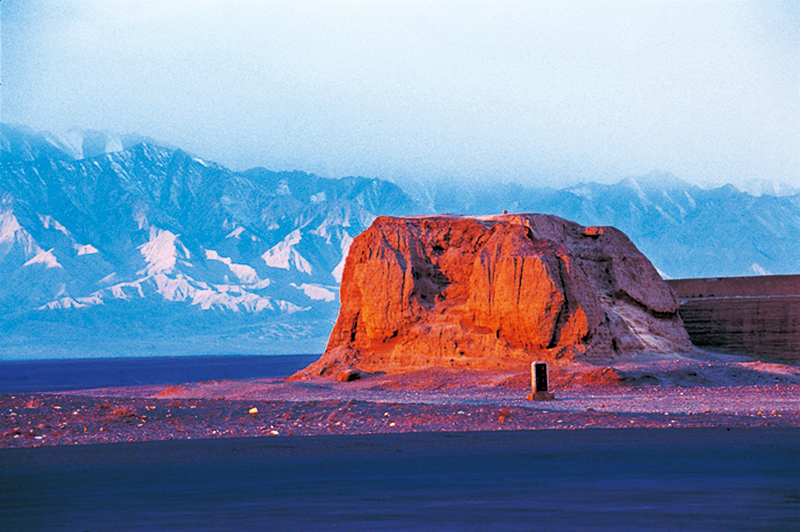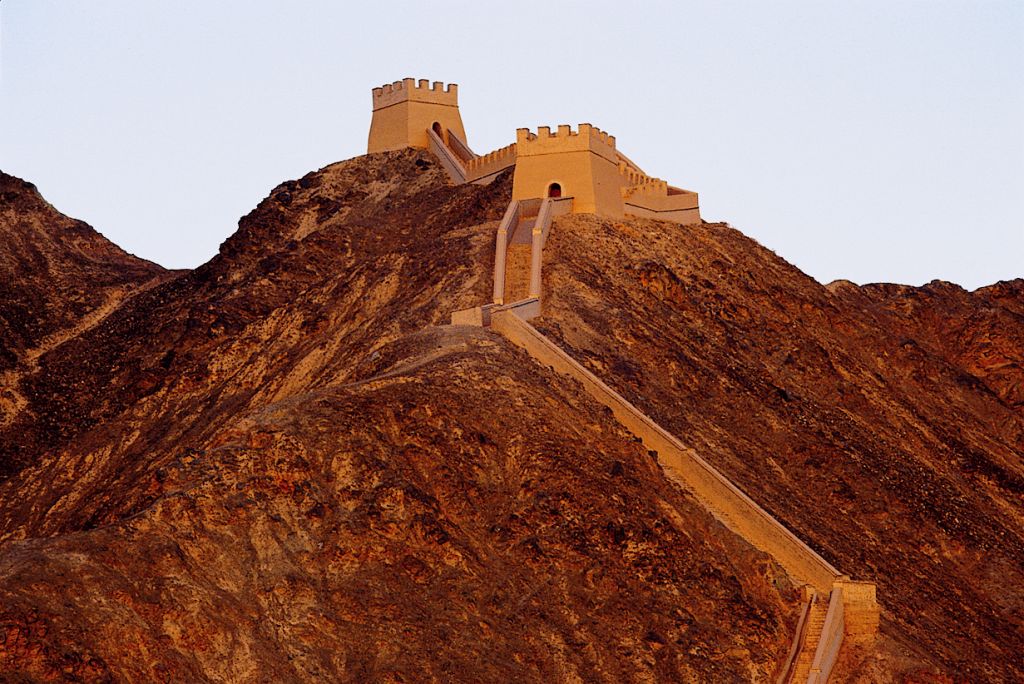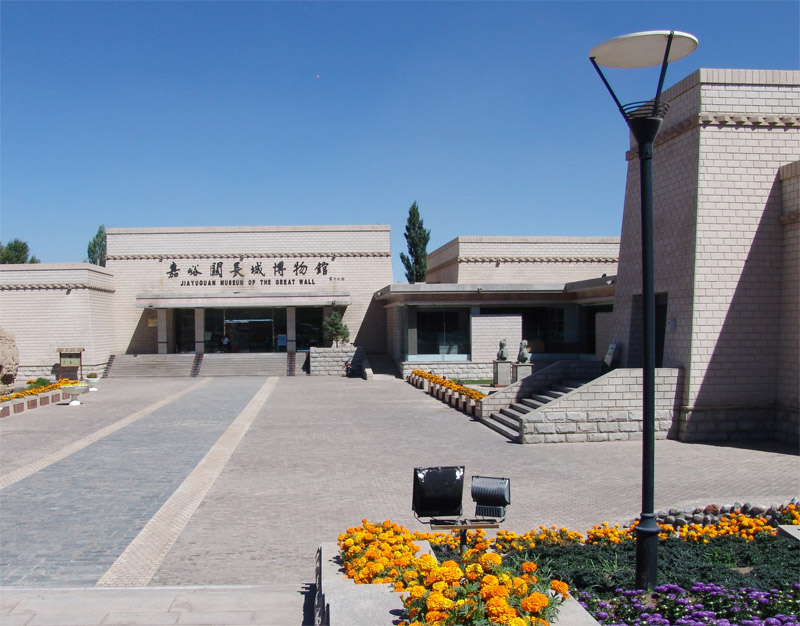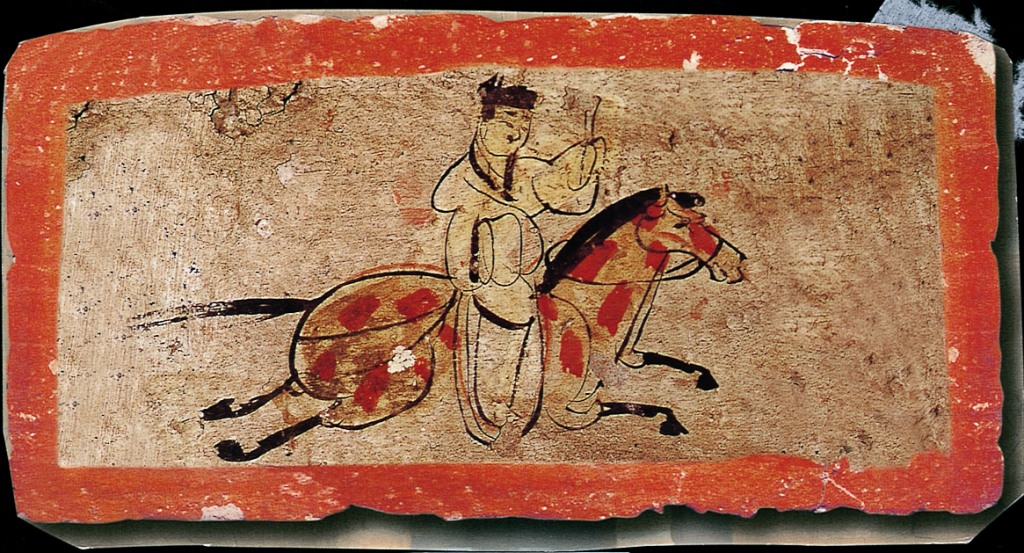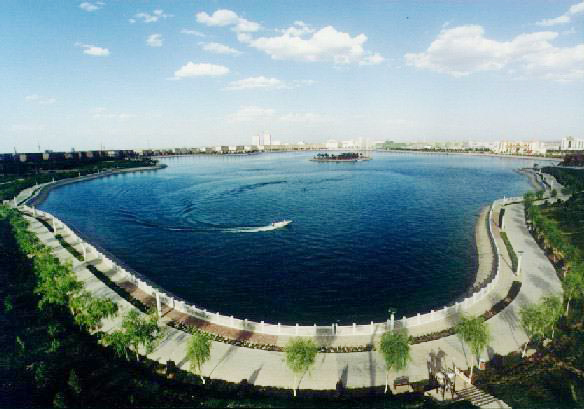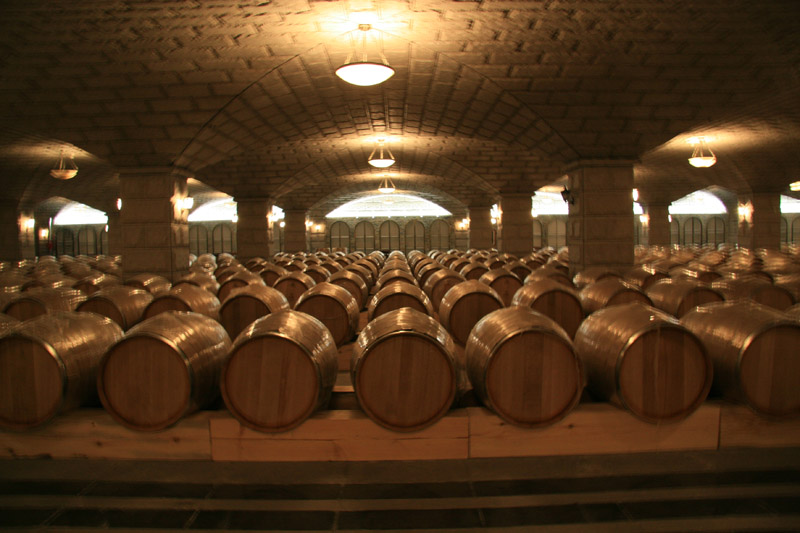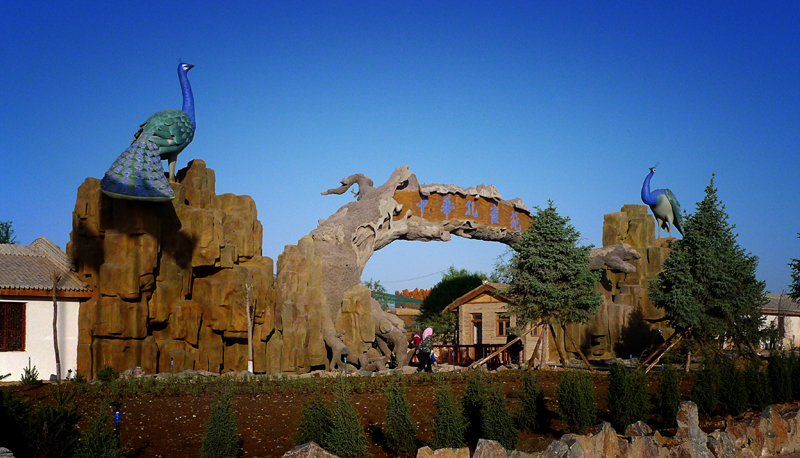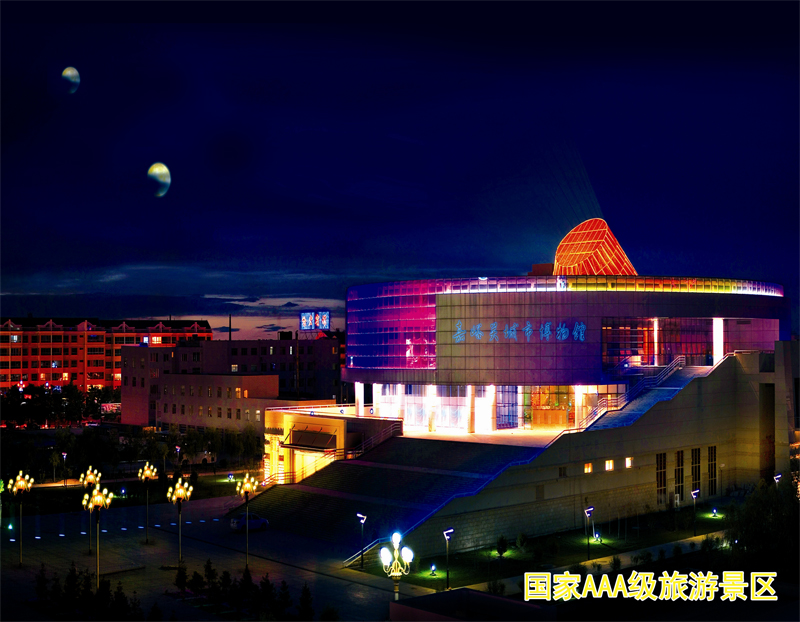Jiayuguan City
Jiayuguan is located in the northwestern Gansu Province and in the middle of the Hexi Corridor. In ancient times it was called Biyu Vale, meaning “fine vale". After the Qin Dynasty, it became a place of military and strategic importance because of its location, hence enjoying the name of “throat of Hexi" and “Lock to the Frontier." The City covers an area of 2935 km2. Its total population is 234.3 thousand. 8 roads are under its jurisdiction. Jiayuguan is a rising modernized city developed with Jiuquan Iron and Steel Company the key construction project of “First-Five-Year Plan". The city gets its name from Juyanguan Pass at the west end of the Great Wall of the Ming Dynasty. It originally belonged to Jiuquan County. In 1955, an iron mine was discovered in Jingtieshan Mountain of Sunan, hence the establishment of the Jiuquan Iron and Steel Company. Then with the original town and some areas under Jiuquan and Sunan Counties’ jurisdiction, the Preparatory Committee for Jiayuguan City in Gansu Province was set up. In 1965, the City was established. In 1971, approved by the State Council, it became the Municipality Directly Controlled by a Provincial Government. The City has a temperate continental desert climate, with an average annual temperature between 6.7℃ to 7.7℃ and annual average sunshine hours of 30000.2. January is the coldest month; the extreme minimum temperature is -28.6℃. July is the hottest; the extreme maximum temperature is 38℃. The best tourist season lasts from May to October each year. And October is the finest time to climb July 1st Glacier. Wearing sunglasses, sunblock and climbing shoes, tourists can experience the joy of conquering the glacier. In the early Ming Dynasty, Feng Sheng, the Duke of Songguo and Great General, chose the west side of Jiayu loess plateau which was a key junction in the middle of the Hexi Corridor, joined with Jiuquan at the east, Yumen at the west, against Black Mountain, and close to Qilian Mountain at the south, to build the pass. Facing water and with a hill at the back, the Pass of Jiayuguan, founded in 1372, guard the canyon land wide 15 km. Taolaihe Valley at the south of canyon was a natural defense of the Pass. Near the Pass, beacon fire towers and alarm stations were intersecting. There are totally 66 alarm stations in each direction of the Pass. Owing to its natural location, Jiayuguan Pass could be both defensive and attacking. It constituted a tight military defense system with the neighboring walls, platforms, moats and beacon fire towers. So it is honored as “Number One Mighty Pass Under the Sun". It is faintly visible that the Silk Road opened up for the economic and cultural communication between China and the West, and beacon fire towers on the ancient battlefield experiencing wars. Here is the intersection of the Silk Road culture and the Great Wall culture. Along the old Silk Road upward to the west, grand Great Wall, numerous cultural relics and works and records, mysterious mountain and water combine to make the ancient road glorious and glittering. Jiayuguan Cultural Relics Scenic Area (AAAAA)
Jiayuguan Cultural Relics Scenic Area, located at the famous Silk Road tourist route, covers an area of 4 km2. It is a comprehensive scenic area built around the “Number One Mighty Pass Under the Sun "——Jiayuguan Pass, centering on the culture of the Great Wall and the Silk Road, and combining culture presentation, sightseeing and recreation. The Pass of Jiayuguan was built in 1372. The whole building process lasted 168 years (from 1372 to 1539). It is the most magnificent and the most important pass among thousands of ones governed by nine towns along the Great Wall of the Ming Dynasty. Because of its strategic location and grandeur it gets the name of “Mighty Pass Under the Sun", “Lock to the Frontier." The Pass is situated on the Jiayu Mountain which is in the middle of the narrowest valley, the highest terrain in the area, 6 km to the southwest of Jiayuguan City. Walls at two wings of the Pass traverse the Gobi desert. 8 km to its north is the Overhanging Great Wall on the Black Mountain; 7 km to its south is Number One Beacon Fire Tower in the World which dominates the west end of the Great Wall of the Ming Dynasty, and is the first pass of Hexi region since ancient times. The Pass consists of inner city, enclosure for defense outside the city gate, outer city, and moat. The center of the Pass is inner city which is 640 meters round, 10.7 meters high, and covers an area of 25 thousand m2. Its walls are constructed with rammed loess. The west front of the wall is wrapped with bricks to make it strong and firm. On the Pass there are dozens of embrasure watchtowers, watchtowers, turrets, garrets, gate buildings. In the city there is general’s mansion, well pavilion, Wenchang Pavilion, Temple Of Guan Yu, memorial arch, opera stage, etc.. A stone tablet over 100 meters west to the Pass reads “Mighty Pass Under the Sun" which is striking echoes with Shanhaiguan Pass——“Number One Pass in the World" million miles away. Number One Beacon Fire Tower along the Great Wall
Number One Beacon Fire Tower, also known as Taolaihe Tower, is a tower at the southernmost tip of the Great Wall at the west of Jiayuguan, and also a tower at the west end of the Great Wall of the Ming Dynasty. If ever the Great Wall is a monument of the Chinese nation, Number One Beacon Fire Tower is the place that this monument rises. Number One Beacon Fire Tower was built in 1539 and supervised by Li Han, the official of rectifying armed force in Sunan. It is standing on the precipice 56 meters above the Taolaihe River where is 7.5 km to the north of the Pass. Along five-thousand-km Ming Great Wall, there are numerous towers. Number One Beacon Fire Tower of the Juayuguan Pass and “Old Dragon’s Head" of the Shanhaiguan Pass at the Bohai Sea, echoing each other at a distance, constitute “head" and “tail" of the Great Wall, and thus achieve the reputation of the Chinese nation——Dragon. Around Number One Beacon Fire Tower, a scenic area is developed. Its natural scenery is grand—— immense Gobi desert joined with magnificent Jiayuguan Pass, rolling Qilian Mountain at its south, at its foot is Taolaihe River originated from Qilian Mountain. Based on desert scenery and the Northwest customs, Number One Beacon Fire Tower scenic area is centering on the Great Wall and the Silk Road culture. It is a fine place for sightseeing, exploration, amusement, nostalgia for ancient times and video shooting. The Overhanging Great Wall
On the left wing of the Jiayuguan Pass, the Overhanging Great Wall is located on the north slope of the Black Mountain that is at the north side of Shiguan Gorge 8 km to the north of the Pass. Built in 1539 and made of slab stones and loess, its original length was 1.5 km. Now only 750 meters of the wall survives. And 231 meters of it made of rammed loess is overhanging on the ridge with a slope of 45。and 150 meters high, which seems like hanging upside down, hence the name “Overhanging Great Wall". Repaired in 1987, the Overhanging Great Wall consists of ramp, crenel walls and beacon fire towers. Three beacon fire towers were built at the head and tail of it. Stepped ramp is built for the convenience of tourists. Although there are only about four hundreds steps, it is enough for tourists to linger over. It is easy to walk on some flat places, while as difficult as though climbing the cliff to walk on some precipitous places. A poem testifies to this: “The Pass along the Great Wall off thousands miles, is overhanging on the Black Mountain ranges." The Great Wall Museum of Jiayuguan
The Great Wall Museum of Jiayuguan, situated at the Cultural Relics Scenic Area, is the first museum about history and culture of the Great Wall. It was built in October 1989, covering an area of 4523.36 m2, with a total construction area of 3499 m2. The main building looks like a beacon tower. In it there are 7 exhibition halls which are displaying the “Great Wall", and are divided into four sections——“The Great Wall of the Spring and Autumn and Warring States Period", “The Great Wall of the Qin and Han Dynasties", “The Great Wall of the Northern Wei, Sui, Tang, Liao, and Jin Dynasties", “The Great Wall of the Ming Dynasty"——which integrate research findings over half century in historical and archeological circles in the form of charts, models and pictures to present three thousand years’ history of the Great Wall from the time of the Warring States to the Ming Dynasty. They not only provide researchers with rich references, but also provide visitors with an overall and quick understanding of the evolution of the Great Wall in space and time. In the Museum, there are also “Ancient Weapon and Equipment Exhibition", “Cultural Relics in Jiayuguan Exhibition", “The Celebrity Calligraphy and Painting Exhibition", and six-thousand pieces of historical relics. So the Museum is honored as “A Textbook of the Great Wall Culture". Frescoed Ancient Tombs of the Wei and Jin Dynasties in Xincheng Township
More than 1400 brick tombs were found at the Gobi Desert outside Xincheng Township 20 km to the northeast of Jiayuguan City. Most of them have large groups of underground frescoes of the Wei and Jin Dynasties (220-419), hence the name of “the largest underground gallery in the world". Among those excavated, eight tombs were frescoed on colored bricks, and over 700 pieces of frescoed bricks were unearthed. Tombs in the Wei and Jin Dynasties have two types: two rooms or three rooms of bricks. They are usually graves of a family. On the tomb gate, colored drawing patterns of clouds, water and fire, four immortals, and spirits and unique animals are carved. The tomb floor is covered with decorative patterned bricks. The walls of the tomb are all brick frescoes presenting the laboring people’s lives and the grave master’s luxury. Frescoed Tombs of the Wei and Jin Dynasties in Xincheng Township have attracted a large number of tourists from home and abroad since the excavation. The frescoes reflect systematically politics, economy, culture, military affairs, folk customs and technology in the Wei and Jin Dynasties. The frescoes, mainly painted with Chinese traditional realist approaches and earlier than the art in the Mogao Grottoes, fill the gap in drawing art of the Wei and Jin Dynasties, and thus are of a great historic interest. Rock Paintings on Precipices of the Heishan Gorge
From 1972 to 1978, on the rock faces of Heishan Gorge 20 km to the northwest of the Jiayuguan City some paintings were found. These paintings were drawn by ancient nomads from the Neolithic Age to the 1st century B.C.. There are 153 pieces of such paintings spread in Hongliu Gully, Mozi Gully and Sidaogu Gully in 2000-km Heishan Gorge. The rock paintings, unique in style, unsophisticated but vivid in picture, simple but elegant in spirit, are of a great art and cultural interest. Their contents include drilling, riding, shooting, hunting, dancing, beasts and insects. In the portraits of “drilling", there are over 30 men in three lines, and every man has his own task to wrestle, fight, shout, and direct. They are a representative of the portraits of “drilling" in Chinese rock paintings. There are hunting and pasturing instead of agricultural production activities in these rock paintings. One cannot find weapons such as knives and spears in the portraits of “drilling". The characters and their dresses are similar in style to those in the portrait of “Battling on Water and Land" on the bronze mirror unearthed in Hui County of Henan Province. They are probably the cultural relics of early Qiang, Darouzhi and Hun people. So they are very valuable for the study of social activities, history, and culture of ancient nomads in Gansu Province. The East Lake Eco-Travelling Scenic Area (AAAA)
The East Lake Eco-Travelling Scenic Area, in the New District of south Jiayuguan City, is the largest ecological project in the urban construction history of Jiayuguan City. The Scenic Area, designed according to the idea of “People First, Water Spirit, Green Base", is a comprehensive eco-travelling scenic area integrating recreation, sightseeing, ecology improvement, sport events organizing, and water storage. Thus it is honored as “the Pearl on the Gobi". The Scenic Area covers an area of 1.65 million m2, including an artificial lake of 560, 000 m2, the Stream River 640 meters long, the Central Square of 30,000 m2, and other spots such as a fall with vestibule, scenic pavilion, green veranda, arch bridge, dock, memorial sculpture of Triathlon, and transition zone. There is also a West Pearl meteorological tower which consists of the podium building, the grid structured tower in the form of a dolphin, the globe and the square. The tower is 99 meters high with 20 stories, among which the ground floor is an exhibition area of the popularization of meteorological science; both the first and the second floor are sightseeing platforms and have teahouses; the thirteenth and fourteenth floor are aerial sightseeing areas equipped with high-powered telescope and are the best place to have a bird’s eye view of Jiayuguan City. Zixuan Wine Estate (AAAA)
Zixuan Wine Estate is situated in the Jiayuguan City where is the junction of the middle and west section of the Silk Road, and the west end of the Great Wall. The Estate covers an area of 654,000 m2 and has an annual output of 50,000 tons middle and top grade wine. The first construction phase has an output of 10,000 tons high quality wine. The construction of the Estate began on 17 June 2005, and the first phase has been completed. Wine production facilities of the international advanced level were built, such as squashing, fermenting, storage and filling equipment as well as the Research and Development Center. The main equipments include French pressers, German cross-flow filters, Italian filling production lines, French and American oak barrels. 13700-m2 Zixuan NO.1 Cellar is the largest wine cellar in Asia. At the same time, production lines and well-equipped Research and Development Center are also built. The Estate’s core function is wine making. It has eight basic steps of wine brewing——harvesting, stemming, pressing, brewing, sulfidizing, mixing, bottling, and sealing. Revolving around the theme of wine, and taking European towns as models, the Estate has many featured functional areas, such as small-scale high-grade leisure club opened only for members, a theme leisure area, a specialized lager cellar, and an appreciation center. The Peacock Garden Scenic Area (AAAA)
The Peacock Garden Scenic Area lies 50 meters to the south side of Jiahuang Highway in Yuquan Town. This is a high-tech and comprehensive ecological scenic area integrating sightseeing, recreation, breeding of Indian Peafowls, and the largest Indian Peafowl theme park in China. At present, the Peacock Garden has a breeding scale of 30 thousand which is a strong support to the appreciation and flying areas. The cultivation base and picking garden of off-season grapes, the high-tech connected greenhouse vegetable growing area, as well as the eco-green area make the breeding areas more ecological. Visitors can not only fully enjoy the charming postures of peacocks, but also the perfect service in the Garden. They can understand the history and culture of peacocks, appreciate impressive peacock cabaret, taste Gansu Cuisine in the restaurant named “Gansu Taste", and learn teaism in “Time on Ancient Road" a teahouse. A trip to the Peacock Garden is a spiritual and cultural travelling about Indian Peafowls. Jiayuguan City Museum (AAA)
Jiayuguan City Museum, situated in east side of Xiongguan Square, is a high-quality project displaying the style and the features of Jiayuguan City. The museum exhibits Jiayuguan’s 50-year development history through material objects, pictures, models, videos, multi-media and so on. The museum vividly portrays hard pioneering days of the constructors from all over the country. |
Jiayuguan City
December 21, 2016
VIEWED: 0
Recommended Products
see all-
Best of Central Europe
HKD 2370 + Book -
Cycle the Danube
HKD 1860 + Book


